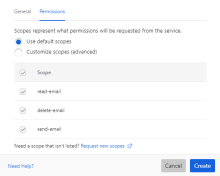Use OAuth 2.0 Client Credentials
OAuth 2.0 is an authorization protocol that grants access to a set of resources like remote APIs or user data.
For more details on OAuth 2.0, see What is OAuth 2.0?
Start this task
To add OAuth 2.0 authentication using the Client Credentials grant type:
-
Click the Overview tab.
-
Click Set up authentication if no authentication methods exist. Otherwise, click Add Authentication.
-
In the Authentication dialog, enter a display name and select OAuth 2.0 from the Auth Type dropdown list.
-
For the Grant Type dropdown menu, select Client Credentials.
-
For the Client Authentication Type dropdown, select one of the following options:
-
Send as basic auth header (client_secret_basic): authentication sends the client credentials in the HTTP authentication header. This is the recommended option.
-
Send as basic auth body (client_secret_post): authentication sends the client credentials within the body of the request.
-
-
Add values to the following fields:
| Field | Definition |
|---|---|
|
Paths |
|
|
Token URL |
The location where the flow sends the client credentials. This field should be a full URL. For example, https://api.box.com/oauth2/token. |
|
Credentials |
|
|
Client ID |
A publicly exposed string provided by the service. This is used to identify the OAuth application and build authorization URLs. The end user populates this field when they create the connection. This field can't be removed and appears as a non-editable field in the Preview window. |
|
Client Secret |
A private value string provided by the service. This value is used to authenticate the application identity to the service. The end user populates this field when they create the connection. This field can't be removed and appears as a non-editable field in the Preview window. |
|
Scopes (Optional) |
|
|
Name |
Each scope defines a precise level of access that the connection requests from the service. To add OAuth scopes to your connection:
When you change any component of your connector authentication including new scopes customizations, the updates don't apply to previously established action cards or connections in your development environment. However, finalized connectors provided by Okta, whether they are first or third-party connectors, don't have this restriction. |
|
Scopes Delimiter |
Specify a delimiter for how individual scopes are separated when entered by the user. Options are Space and Comma. |
|
Parameters (Optional) |
Parameters allow you to collect additional information from the connector user that might be necessary for authentication, such as their instance or subdomain. These fields are presented to the user when they first create a connection and are required. Label: The name for the parameter that is shown on the New Connection dialog when setting up the connector. Key: Text value in the key-value pairing that the service uses. For example, api_key, application_key, or authentication. Type: You can select three different field types:
For a Client Credentials grant type, the Client ID and Client Secret parameters appear by default. You can add text to create a unique name for these labels, but these parameters can't be removed. |
|
Config Values (Optional) |
Other configuration values may be needed to define how a user authenticates to your connector. Click Add Config Value. Label: The name for the configuration value that is shown on the New Connection dialog when setting up the connector. Definition: Indicate whether this field is populated with a static value or a value from a helper flow.
Type: You can select two different field types:
The Visible toggle determines whether the configuration value appears in the authentication dialog for the connector. |
Next steps
After you create this authentication method, you need to create an httpHelper flow to manage calls through the authentication method. See Build an httpHelper flow.



